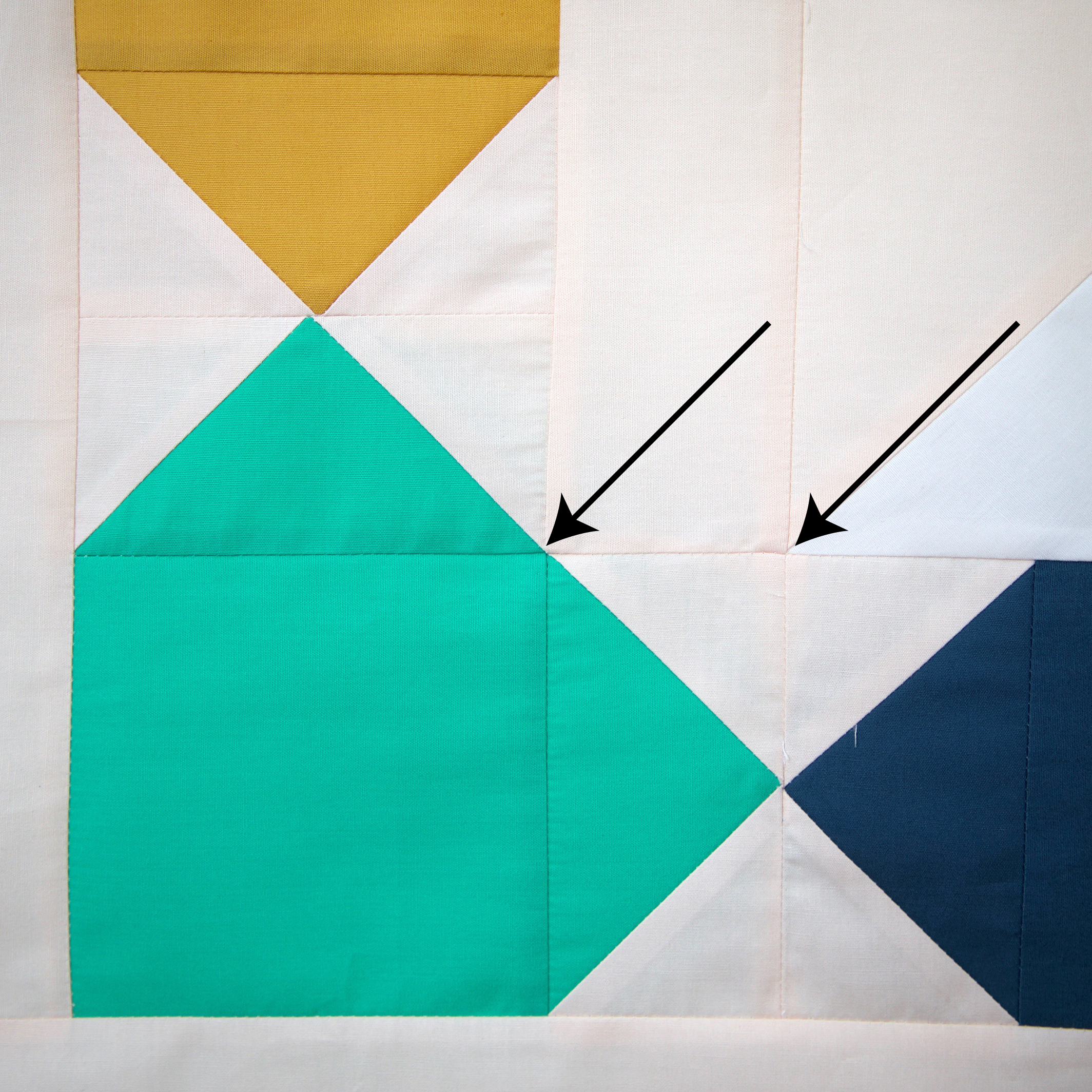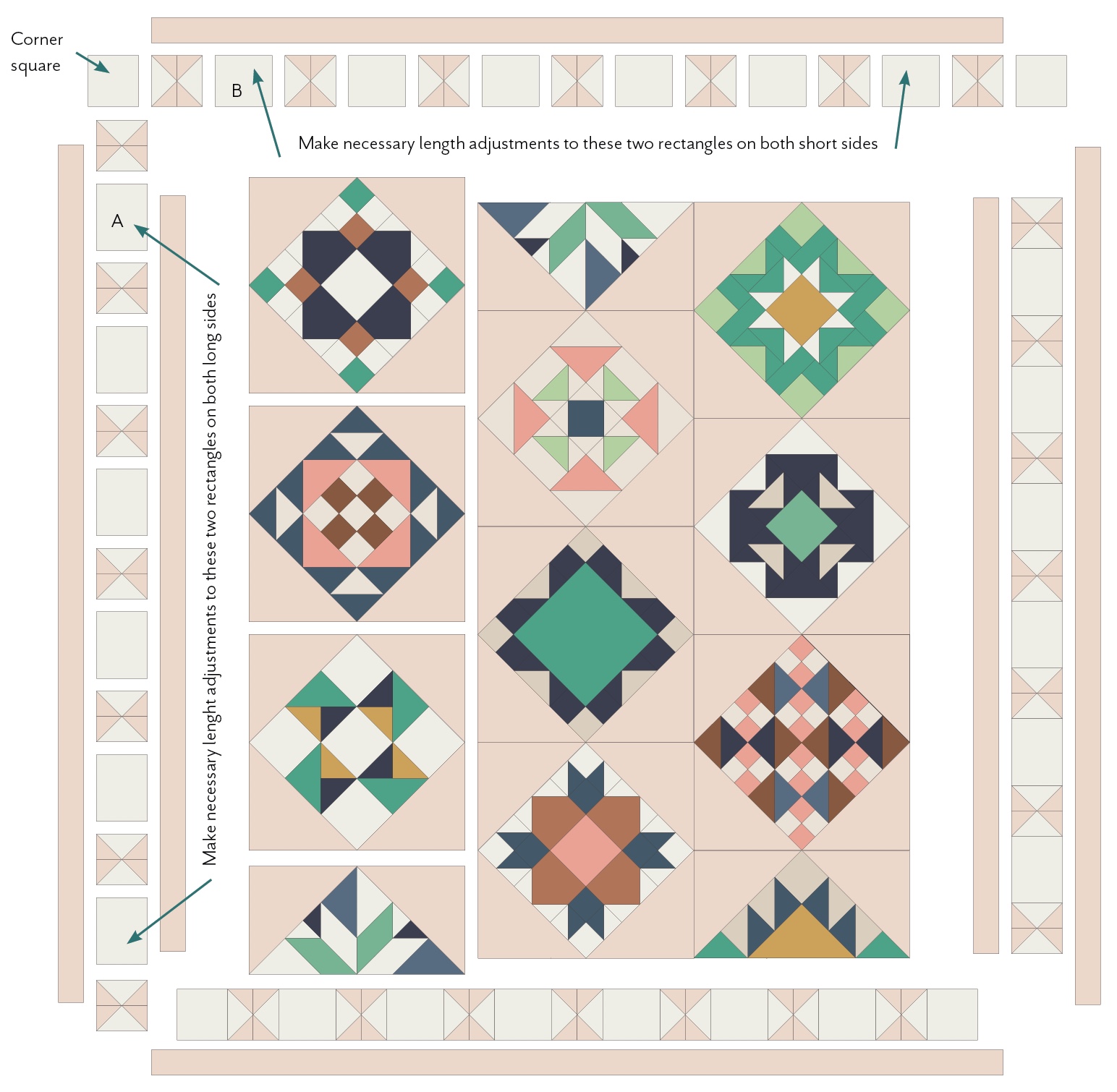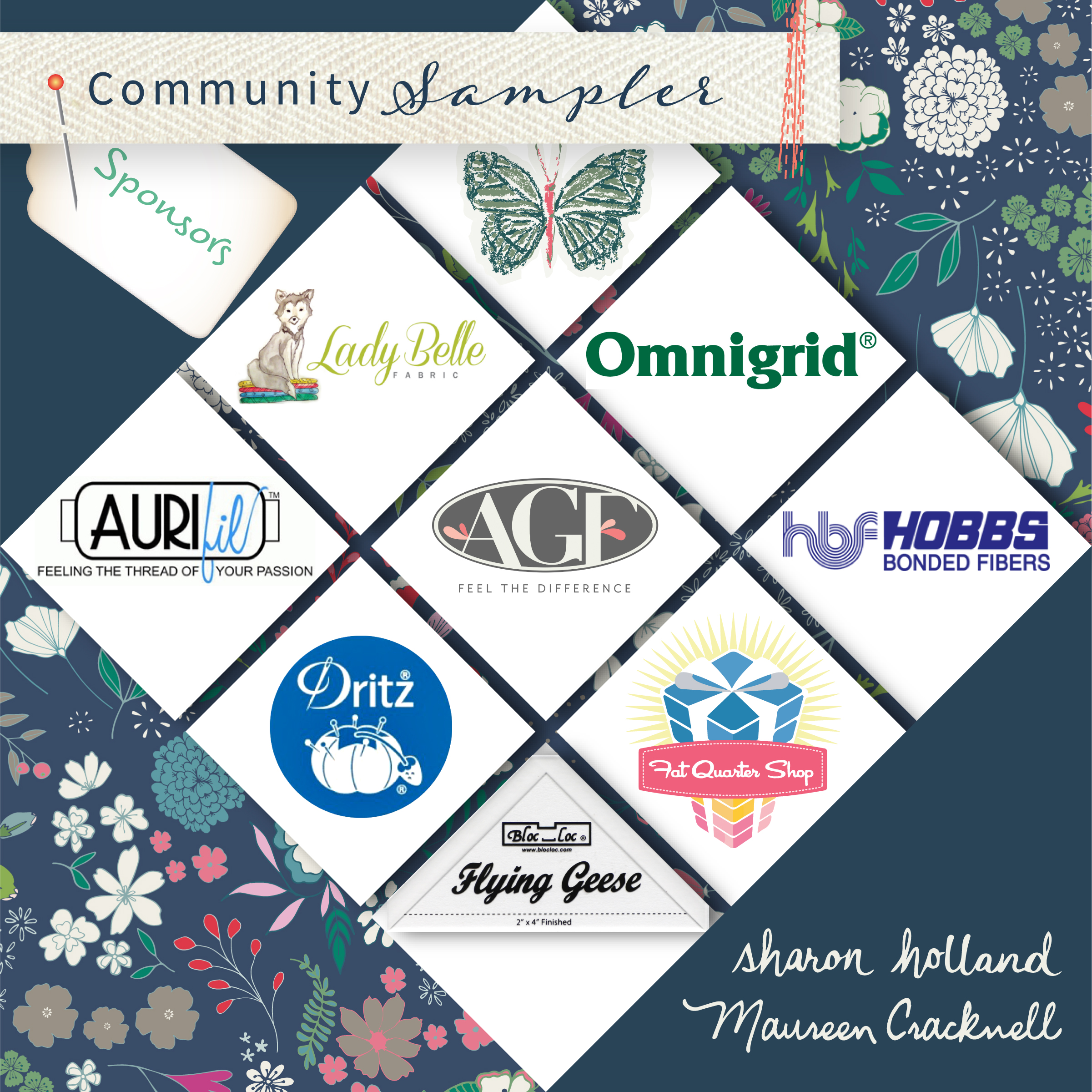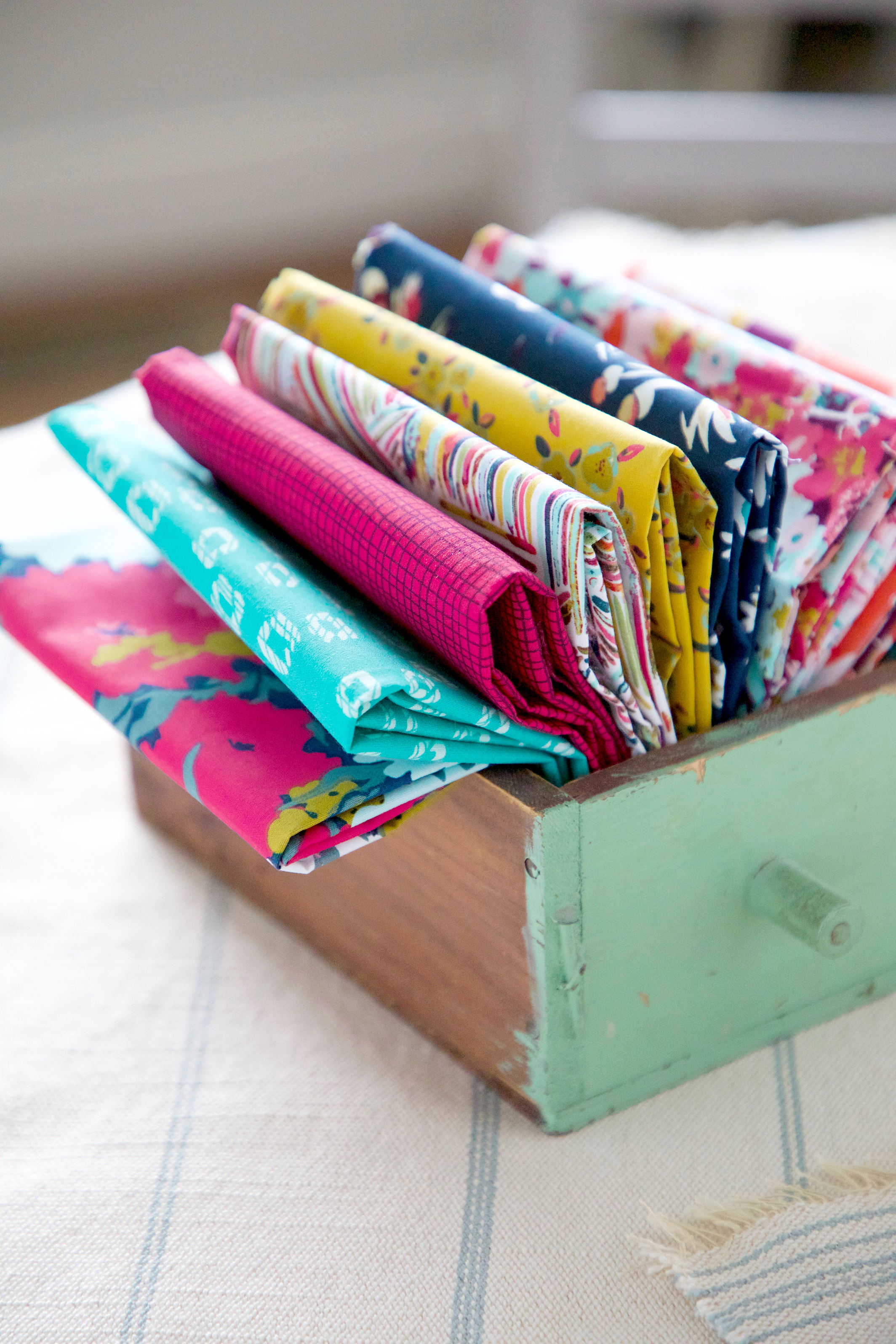Community Sampler Week #14
It's bitter-sweet that we're at the border assembly part of our sew along. This week we'll put on the optional borders and have a finished top! Looking ahead, next week Maureen and I will post about how to sandwich your top, batting, and back and I'll have some suggestions for quilting. The final week #16 is the full reveals and grand finale prize giveaway so stick with us just a few more weeks.
If you've just found out about this sew along, don't worry, you can still join in on the fun but you may want to start from the very first post and work up to the present. There are eleven blocks in our quilt, block setting, and optional borders. Each Wednesday will be a new PDF block release or finishing step for the quilt. If you are just joining us, pick up the Introduction PDF on the Sew Along page and you'll get a material list along with coloring pages so you can get started planning your quilt. Then, work your way through the first Community Sampler post to the present.
My co-host and sister Art Gallery Fabrics designer Maureen Cracknell and I are so happy to have you sewing with us and can't wait to see your finished quilts.
Accurate cutting and use of a true 1/4'' seam allowance is a must for successful patchwork piecing. All your set blocks will measure 17-1/2'' square (unfinished). Review how to cut strips, sew with a true 1/4'' seam allowance, and other helpful piecing tips on my "Are You Ready to Sew" post.
Let's add some borders! Download the free PDF on the Sew Along page.
If you're using directional prints, you may want to check out my tutorial for controlling directional prints that was posted during the Sewcial Bee Sampler sew along. I know you know how to stitch our No-Waste Flying Geese by now but if you'd like to look back on our past tutorial, revisit week #3 post, here.
Those of you that may have made your quilt bigger by adding more blocks will need to increase the length your borders and more materials will be needed for the added size.
Adding the Borders
In a perfect world we all could sew perfectly square blocks that are true to size but let's face it, that rarely happens. The cutting and piecing sizes given in our PDF Borders instruction are written for that perfect case senecio which means you're probably going to make a few tweaks to your cutting and piecing to get this baby together.
Cut and stitch your Flying Geese (FG) units to the size given in the instructions, making them 2-1/2'' x 4-1/2'' (unfinished). Please read the rest of this blog post and through all the instructions on the PDF before cutting the A and B rectangles for the pieced borders.
My original plan for my quilt was to make all the Flying Geese units and rectangles white on a peach/pink background to match the block setting background solid. But, the peach/pink is a very light shade and to do all that Flying Geese and rectangle piecing in white against light seemed like a waste of all that piecing! I decided to select a few mid-tone solids that were predominate in the blocks and do a mixed solids border treatment. To do this I needed to divide the number of different fabrics by the number of "pop beads" as I like to call the border shapes. Remember, that with every No-Waste Flying Geese method you'll get four units in the end and will need one 5-1/2" square and four 3-1/8" squares to get four matching FG units. The PDF instructions give the total number needed (if using the size of quilt given) to cut so use those numbers as a guide when dividing in your number of fabrics.
I'd run out of enough fabric to include a terra cotta colored pop bead so I substituted with the more muted PE-472 Cinnamon of Art Gallery Fabrics Pure Elements color seen on the far right of the above photo.
As you can see, the Flying Geese units will measure up nicely to the 4-1/2" square corner squares in the pieced border and the 2-1/2"-wide inner border (even though my points are less than perfect, you get the idea here :).
You're quilt center (before adding any of the borders) should be measuring somewhere in the neighborhood of 51-1/1" x 60". If you're way off that mark or increased the size of your quilt by adding more blocks you'll need to make some adjustments...
Obviously, if you've made a larger quilt than our sampler you will need to get out the calculator and cut more strips for those inner and outer boarders and make additional Pop Beads in the middle borders. Note that the rectangles in the Pop Beads are two different sizes and are labeled A and B on the PDF instructions.
Before you really get crazy and cut all the A and B rectangles, cut just a couple (and label) then sew some of the Flying Geese units to rectangles and check your sizing.
Since the B rectangle/Flying Geese units are stitched directly against the top and bottom of the quilt (no inner border between) that's a good place to start for checking sizes. If your seams match up on major points and seams of the quilt top center then you're in that perfect world senecio and are in good shape to proceed with piecing the borders as given in the instructions.
If you're considerable off you have two options.
One, do the math to figure what sort of adjustment is needed to the A and B rectangles to hit on those major seams in the quilt top center. Start by measuring the opposite sides of the top and average those number (subtract 1/2" for total seam allowances and work in finished sizes for now). Each FG pair will measure 4'' finished so add up the number of 4'' units needed. From the remaining amount, figure how many rectangles are needed. Divide that amount by the number of rectangles needed to get the total length per rectangle. Remember to add in the seam allowances after figuring the finished length needed for an A or B rectangles. Yeah, I know, no fun at all.
Okay, option two. Cut and piece as stated in the instructions (unless of course you need to cut more because you made a bigger quilt). After piecing each border section as directed, the adjustments will be made to the end rectangles only. You're border may not hit on the major seams and points of the quilt top but will be easier to figure up and still look balanced in the end.
Remember, don't change the 4-1/2" measurement on any of the rectangles as this side will match the length of the Flying Geese units and corner squares.
I truly hope these pieced borders don't cause heartache and frustration but I do want to cover any possible problems that could occur do to the variables of sewing. Do a few samples like stated above and test the waters before jumping in.
If you're not up to this challenge then maybe consider a simple 4" -wide finished solid middle border (4-1/2" x length needed cut size) and follow the same steps as for making the inner and outer border.
Remember to use your sew along community on Instagram (#CommunitySampler) if you have questions or need some moral support!
COMMUNITY SAMPLER SPONSORS
My co-host Maureen Cracknell and I are continually amazed by the joy and excitement each of you bring to our virtual community. Thank you for making this sew along so special. Please visit Maureen's blog and see the progress she's making on her sampler quilt, using her beautiful AGF fabrics Love Story collection. Be sure to use the #CommunitySampler hashtag when posting your blocks to Instagram and tag both my @sharonhollanddesigns and @maureencracknell so we don't miss any of your beautiful work! But, please be patient with both Maureen and I over the next few weeks if we don't comment back. Both Maureen and I are preparing sewing samples for our new spring collections and there's just not enough hours in the day (or energy) to get it all done!
Don't forget that this Friday's a Giveaway Friday on the Community Sampler sew along. Maureen and I will take turns hosting a giveaway each week where one of our generous sponsors will be featured and offering amazing prizes both here on our blogs and also on Instagram. I'll be hosting the giveaway this Friday and you'll be instructed how to enter at that time.
Happy sewing!

































